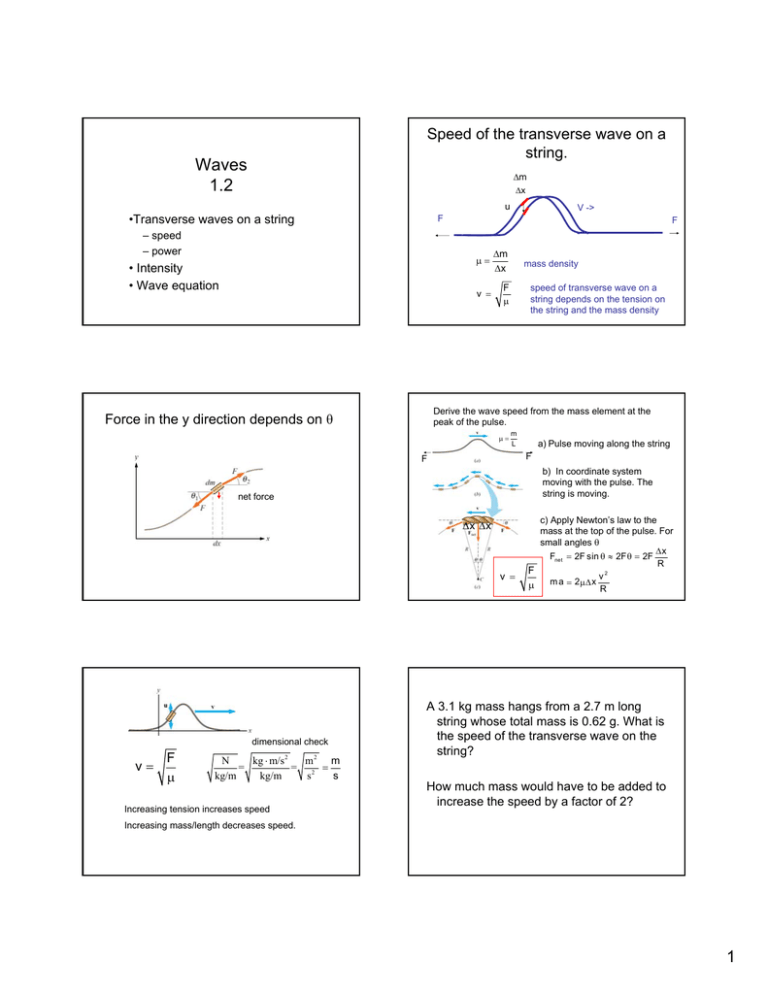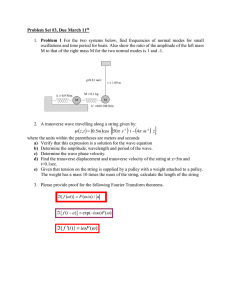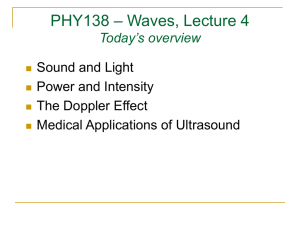Waves 1.2 Speed of the transverse wave on a string.
advertisement

Speed of the transverse wave on a string. Waves 1.2 ∆m ∆x u •Transverse waves on a string V -> F – speed – power • Intensity • Wave equation F µ= ∆m ∆x v = F µ mass density speed of transverse wave on a string depends on the tension on the string and the mass density Derive the wave speed from the mass element at the peak of the pulse. Force in the y direction depends on θ µ= m L b) In coordinate system moving with the pulse. The string is moving. net force ∆x ∆x v = dimensional check F v= µ N kg ⋅ m/s 2 m2 m = = 2 = kg/m kg/m s s Increasing tension increases speed a) Pulse moving along the string F F c) Apply Newton’s law to the mass at the top of the pulse. For small angles θ ∆x Fnet = 2F sin θ ≈ 2F θ = 2F R F v2 m a = 2 µ∆ x µ R A 3.1 kg mass hangs from a 2.7 m long string whose total mass is 0.62 g. What is the speed of the transverse wave on the string? How much mass would have to be added to increase the speed by a factor of 2? Increasing mass/length decreases speed. 1 Power carried by harmonic wave Average power Pav average power is the energy in one wavelength / period V Pav = u E(λ ) T For a harmonic oscillator the average KE is equal to the average PE so the total energy is 2xKE =mu2 Displacement is in the vertical , Y direction, Displacement speed u in the Y direction Wave carries Kinetic and Potential energy due to the displacement. 2KE Pav = = T Average Power Instantaneous power varies with time. y = A cos(kx − ωt) ∂y = ωA sin(kx − ωt) u= ∂t u2 = ω2 A 2 sin2 (kx − ωt) P=µvu2 P = µvω2 A 2 sin2 (kx − ωt) 38. A steel wire with linear density of 5.0 g/m is under 450 N tension. What is the maximum power that can be carried by transverse waves if the wave amplitude is not to exceed 10% of the wavelength? 1 2( mu 2 ) µλ u 2 2 = = µvu 2 T T the average value of sin2(kx-ωt) over one cycle is 1/2 1 2 2 µω A v 2 1 Pav = FkωA 2 2 Pav = since ω = kv v2 = F µ The power depends on A squared for many systems Intensity • Intensity is defined as the power per area I= P Area (Watt/m2) 2 For different geometries the intensity can vary with distance from the source. Question You are reading a book using light from a single light bulb. At a distance of 2 m from the bulb the intensity is too low. To increase the intensity by a factor of 2 you need to go to a distance of_____ m from the bulb. a) 1.0 m b) 0.5 m c) 1.4 m d) 2.0 m Wave propagates in one direction- Plane wave Intensity is constant with distance Wave propagates radially Spherical wave Intensity varies as 1/r2 I= P 4πr 2 The wave equation F=ma • Goal: • F = restoration force in the string • a = acceleration in y direction • F = m a is Newton’s law applied to the “oscillators” in the string that “swing” vertically on the string as the wave passes by! – We will evaluate Newton’s law F = m a for the system of a wave on a string. – We will specifically look at dF, the change in F as we go from x to x+dx • Result: – We will find a universal equation that applies to all wave phenomena. In fact, it defines wave phenomena. All physical systems that follow this equation will display waves. Consider the net force acting on the segment of string Tanθ is a derivative tan θ = dFy = Fy2 − Fy1 Fy2 dFy = F(tan θ2 − tan θ1 ) Net force in Y direction small angle approximation ∂y ∂x tan θ2 − tan θ1 = Fy1 = ∂2y dx ∂x 2 ⇒ dF = F sin θ = tan θ ∂y ∂y − ∂x x + dx ∂x x ∂2y dx ∂x 2 3 Newtons Law Significance of wave equation dF=dm a ∂2y dx = µ ∂x 2 ∂2y µ ∂2y = ∂x 2 F ∂t2 2 ∂ y 1 ⇒ = 2 2 v ∂x F • All physical phenomena that lead to a relationship described by the wave equation will exhibit waves !!! • Examples: ∂2y dx ∂t2 Since v = ∂ y ∂t2 F µ – Sound – Electromagnetism – General Relativity (i.e. Gravity) 2 Wave Equation y(x,t) = A cos(kx-ωt) • We can show explicitly that this general form obeys the wave equation. • As a homework excercise show that this function satisfies the wave equation. 4





